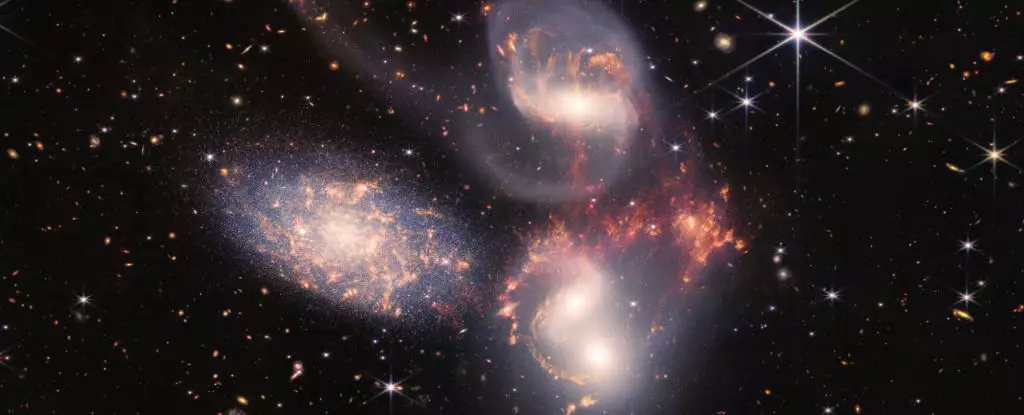The cosmos presents us with a spectacle so grand that it reshapes our understanding of galactic behavior. Located a staggering 290 million light-years away, Stephan’s Quintet—a cluster of four galaxies—offers a dynamic study in gravitational interactions and cosmic upheaval. Recent advancements in observational technology have unveiled not just the vastness of this interaction but its intricacies and complexities.
Imagine a region of space pulsing with the energy of galactic collisions. Stephan’s Quintet, though often mistaken for a five-galaxy cluster from Earth, actually consists of four closely intertwined galaxies engaged in a bizarre yet beautiful gravitational dance. The fifth entity, an impostor, lies 40 million light-years further away and offers no contribution to the drama at hand. A key character in this scene is NGC 7318b—a galaxy careening through the quartet at mind-boggling speeds, akin to a cosmic wrecking ball, blasting through intergalactic space at 3.2 million kilometers per hour (or about 2 million miles per hour). This high-speed collision creates a shock front that illuminates the vast space between the galaxies, much in the same way as a sonic boom disrupts the air around a jet fighter.
A Breathtaking Display of X-rays and Shockwaves
The recent observations using the William Herschel Telescope’s Enhanced Area Velocity Explorer (WEAVE) have provided scientists with an unprecedented look into the functioning of this galactic ensemble. Notably, these new findings detail the behavior of shocked gas, a product of NGC 7318b’s rapid passage through the galaxy cluster. The shock front—a ripple of energy that expands significantly larger than our own Milky Way—indicates a complex interplay of high-energy processes. Notably, the gas behind the shock transforms, exhibiting a dual nature; when traversing cold gas, it manifests hypersonic behavior that tears apart atomic structures, while it dissipates through hotter gases, causing compression and a glow detectable by radio telescopes.
This cascading energy cycle provides vital insights into how clusters like Stephan’s Quintet influence the gaseous environment around them. The data indicate that energized particles in the gaseous medium have been reacting for up to 11 million years, a reflection of the time since NGC 7318b initiated its reckless journey through the region.
Such complex structures and their interactions are critical for understanding the broader cosmic ballet. Observations of Stephan’s Quintet reveal not only how galaxies collide and coalesce but also how these events shape subsequent galactic formations across the universe. The findings of astrophysicists, including Marina Arnaudova and Gavin Dalton, emphasize that close proximity to Earth grants us a unique lens through which to examine these phenomena. The rarity of such intertwined galaxies so near to us makes each discovery within this cluster a key to unlocking cosmic mysteries.
These investigations into galactic mergers and interactions are not mere academic pursuits. They form the backbone of our understanding of how larger galaxies, like our own Milky Way, evolve through moments of collision and cosmic consumption. As smaller galaxies are subsumed in these grand interactions, they contribute to the growth of larger cosmic entities, thereby changing the structure of the universe over billions of years.
As we advance technologically, the quest to understand cosmic phenomena like those in Stephan’s Quintet is poised to become even more comprehensive. New instruments and observational tools will continue to unveil the hidden details of these dynamic interactions. With each revelation, we edge closer to comprehending the forces that drive the universe.
The ongoing activity within Stephan’s Quintet serves as a captivating case study in cosmic evolution and interaction. As galaxies collide and coalesce, they leave behind intricate patterns of debris and energy that illuminate the vastness of space. Our growing understanding of these processes not only fuels our thirst for knowledge but also strengthens our connection to the universe we inhabit. The majestic ballet of galaxies will undoubtedly continue to inspire awe and curiosity for generations of astronomers and cosmic enthusiasts alike.

